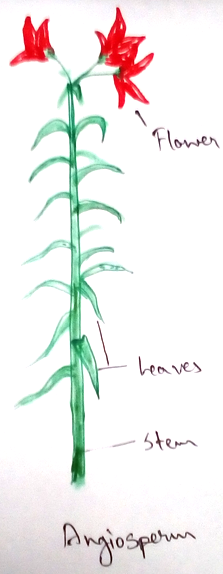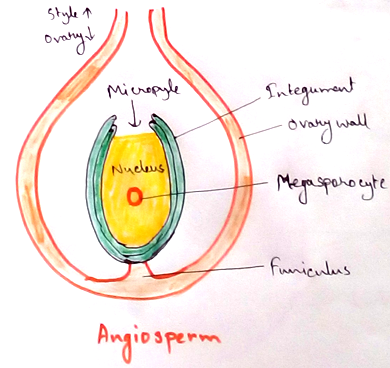Angiosperms
The plant group that shared possession of flower like reproductive characters are called anthophytes. The group consider anthophytes are Bennettiales, gametophytes and angiosperms. About 2,35000 angiosperms are discovered. Among them 65,000 are monocot and 1,65,000 are eudicot species.
Characteristics of angiosperms:
1. Formation of flowers with closed carpels.
2. Double fertilization leading to endosperm formation.Macrosporophylls becomes modified into stamens while megasporophyls have produced carpel with stigmatised surface for receiving pollen grains.
3. A three nucleate micro gametophyte and an eight nucleated megagametophyte.
4. Stamens contain two pairs of pollen sacs. Female gametophyte is called embryo sac.It is 8 nucleate and 7 celled where archegonium is absent.
5. The presence of sieve tubes and companion cells in the phloem.
6. Angiosperms are divided into two – monocot and dicots due to presence of their umber of cotyledons.
Basic characteristics of monocots are:
(i) Plants with single cotyledons.
(ii) Radical aborting early in growth with the development adventitious root system.
(iii) Vascular bundles are complex andrarely showing secondary growth.
(iv) Leaves with parallel venation.
(v) Flowers are 3 merous.
(vi) Pollen grains usually monosulcate.
(vii) Sieve cell plastid with several cuneate protein crystals.
(viii) Pollens are monoaperturate.
(ix) Monocots are different types. They are:
1. Orchidaceae – Largest family of this category which contain flowering plants.
2. Poaceae – About half of the as many species are made up of true grass. Economically they are important because it includes grain (rice, bamboo, wheat, maize etc) which have economic importance.
3. Arecaceae - Some crops and palms are included in this category.
4. Musaceae - This include banana, plantain, ginger etc.
5. Zingiberaceae – This also contain some products like turmeric and cardamom.
6. Asparagaceae – Asparagus included in this category.
7. Bromiliaceae – Pine apples belong to this category.
8. Cyperaceae – Water chestnut are included in this category.
9. Amaryllidaceae - This category includes leeks, onion, garlic etc which have economic importance.
Basic characteristics of dicotyledon are:
1. Plants with two cotyledons are called dicotyledon plants
2. Radical, giving rise to mature root system and not aborting.
3. Vascular bundles in ring and often showing secondary growth.
4. Leaves with reticulate venation pattern.
5. Flowers four or five merous.
6. Pollen grains predominantly tricolpate or modifications there of.
Dicotyledon can be divided into different category. They are:
1. Eudicoits - It is monophyletic group having tricolpate pollen.
2. Magniliids - It represents families of dicotyledon including Magnoliales, Laurales and Illiciales.
3. Amborella – Molecular phylogenetic put it as sister of other flowering plants as it hasdifferent types of xylem than other plants.
4. Nymphaeales - It is aquatic, rhizomatous herbs, with laticifers, placentation parietal and seeds are usually operculate.
5. Austrobaileyales - Woody vines mostly found in tropical and temperate zone.
6. Chloranthales – They are fragrant herbs or shrubs which have the medicinal properties.
7. Ceratophyllum - It is unique among angiosperms. As it passes in life cycle completely underwater. This interesting feature indicates its primitive ness.
Question and answers on Angiosperms:
Which is the largest angiosperm of the world?
Some species of Eucalyptus may reach up to 100 meters in height with trunks near 20 meter in girth.
Recent Articles
-
Explain about Growth in Plants |Definition of Growth & Differentiation
Feb 27, 25 02:07 PM
Growth is a permanent increase in length or volume of an organism that brought upon by an increase in its dimensions due to synthesis of new protoplasmic material. -
Definition of Respiratory Quotient | calculation | Application | Plant
Dec 02, 24 12:09 AM
Definition of respiration quotient- the ratio of the carbon-dioxide evolved to that of the oxygen consumed by a cell, tissue, plants or animals in a given time is called respiratory quotient. It is us… -
Amphibolic Pathway | Definition | Examples | Pentose Phosphate Pathway
Jun 06, 24 10:40 AM
Definition of amphibolic pathway- Amphibolic pathway is a biochemical pathway where anabolism and catabolism are both combined together. Examples of amphibolic pathway- there are different biochemical… -
Respiratory Balance Sheet | TCA Cycle | ATP Consumption Process
Feb 18, 24 01:56 PM
The major component that produced during the photosynthesis is Glucose which is further metabolised by the different metabolic pathways like glycolysis, Krebs cycle, TCA cycle and produces energy whic… -
Electron Transport System and Oxidative Phosphorylation | ETC |Diagram
Feb 04, 24 01:57 PM
It is also called ETC. Electron transfer means the process where one electron relocates from one atom to the other atom. Definition of electron transport chain - The biological process where a chains…






New! Comments
Have your say about what you just read! Leave me a comment in the box below.